Swith [COMPUTERS & SCIENCE]
6775件中 1件 - 30件
1 2 3 4 5 6
| 商品 | 説明 | 価格 |
|---|---|---|
 Statistical Shape Analysis With Applications in R【電子書籍】[ Ian L. Dryden ] 楽天Kobo電子書籍ストア | <p><strong>A thoroughly revised and updated edition of this introduction to modern statistical methods for shape analysis</strong></p> <p>Shape analysis is an important tool in the many disciplines where objects are compared using geometrical features. Examples include comparing brain shape in schizophrenia; investigating protein molecules in bioinformatics; and describing growth of organisms in biology.</p> <p>This book is a significant update of the highly-regarded <em>Statistical Shape Analysis</em> by the same authors. The new edition lays the foundations of landmark shape analysis, including geometrical concepts and statistical techniques, and extends to include analysis of curves, surfaces, images and other types of object data. Key definitions and concepts are discussed throughout, and the relative merits of different approaches are presented.</p> <p>The authors have included substantial new material on recent statistical developments and offer numerous examples throughout the text. Concepts are introduced in an accessible manner, while retaining sufficient detail for more specialist statisticians to appreciate the challenges and opportunities of this new field. Computer code has been included for instructional use, along with exercises to enable readers to implement the applications themselves in R and to follow the key ideas by hands-on analysis.</p> <ul> <li>Offers a detailed yet accessible treatment of statistical methods for shape analysis</li> <li>Includes numerous examples and applications from many disciplines</li> <li>Provides R code for implementing the examples</li> <li>Covers a wide variety of recent developments in shape analysis</li> </ul> <p><em>Shape Analysis, with Applications in R</em> will offer a valuable introduction to this fast-moving research area for statisticians and other applied scientists working in diverse areas, including archaeology, bioinformatics, biology, chemistry, computer science, medicine, morphometics and image analysis.</p>画面が切り替わりますので、しばらくお待ち下さい。 ※ご購入は、楽天kobo商品ページからお願いします。※切り替わらない場合は、こちら をクリックして下さい。 ※このページからは注文できません。 | 14,581円 |
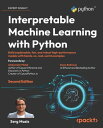 Interpretable Machine Learning with Python Build explainable, fair, and robust high-performance models with hands-on, real-world examples【電子書籍】[ Serg Mas?s ] 楽天Kobo電子書籍ストア | <p><b>A deep dive into the key aspects and challenges of machine learning interpretability using a comprehensive toolkit, including SHAP, feature importance, and causal inference, to build fairer, safer, and more reliable models. Purchase of the print or Kindle book includes a free eBook in PDF format.</b></p><h2>Key Features</h2><ul><li>Interpret real-world data, including cardiovascular disease data and the COMPAS recidivism scores</li><li>Build your interpretability toolkit with global, local, model-agnostic, and model-specific methods</li><li>Analyze and extract insights from complex models from CNNs to BERT to time series models</li></ul><h2>Book Description</h2>Interpretable Machine Learning with Python, Second Edition, brings to light the key concepts of interpreting machine learning models by analyzing real-world data, providing you with a wide range of skills and tools to decipher the results of even the most complex models. Build your interpretability toolkit with several use cases, from flight delay prediction to waste classification to COMPAS risk assessment scores. This book is full of useful techniques, introducing them to the right use case. Learn traditional methods, such as feature importance and partial dependence plots to integrated gradients for NLP interpretations and gradient-based attribution methods, such as saliency maps. In addition to the step-by-step code, you’ll get hands-on with tuning models and training data for interpretability by reducing complexity, mitigating bias, placing guardrails, and enhancing reliability. By the end of the book, you’ll be confident in tackling interpretability challenges with black-box models using tabular, language, image, and time series data.<h2>What you will learn</h2><ul><li>Progress from basic to advanced techniques, such as causal inference and quantifying uncertainty</li><li>Build your skillset from analyzing linear and logistic models to complex ones, such as CatBoost, CNNs, and NLP transformers</li><li>Use monotonic and interaction constraints to make fairer and safer models</li><li>Understand how to mitigate the influence of bias in datasets</li><li>Leverage sensitivity analysis factor prioritization and factor fixing for any model</li><li>Discover how to make models more reliable with adversarial robustness</li></ul><h2>Who this book is for</h2><p>This book is for data scientists, machine learning developers, machine learning engineers, MLOps engineers, and data stewards who have an increasingly critical responsibility to explain how the artificial intelligence systems they develop work, their impact on decision making, and how they identify and manage bias. It’s also a useful resource for self-taught ML enthusiasts and beginners who want to go deeper into the subject matter, though a good grasp of the Python programming language is needed to implement the examples.</p>画面が切り替わりますので、しばらくお待ち下さい。 ※ご購入は、楽天kobo商品ページからお願いします。※切り替わらない場合は、こちら をクリックして下さい。 ※このページからは注文できません。 | 4,304円 |
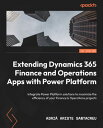 Extending Dynamics 365 Finance and Operations Apps with Power Platform Integrate Power Platform solutions to maximize the efficiency of your Finance & Operations projects【電子書籍】[ Adri? Ariste Santacreu ] 楽天Kobo電子書籍ストア | <p><b>Unlock the potential of Dynamics 365 Finance and Operations apps by creating innovative solutions that can enhance the performance of your projects</b></p><h2>Key Features</h2><ul><li>Learn how to leverage Power Platform tools with Dynamics 365 Finance & Operations</li><li>Work on real-world use cases and discover ways to maximize the potential of Power Platform</li><li>Adopt a low-code approach to expedite the development process and enhance the overall maintainability of F&O projects</li><li>Purchase of the print or Kindle book includes a free PDF eBook</li></ul><h2>Book Description</h2>Uncover the synergy between Microsoft Power Platform and its integration with Dynamics 365 Finance & Operations (F&O) with this essential guide to implementing low-code and no-code concepts to not only extend and enhance F&O but also improve maintainability and speed up development. Systematically exploring Power Platform, this book covers topics such as Dataverse, Power Automate, Power Apps, and Power BI using real-world scenarios in Dynamics 365 F&O to offer practical insights. You’ll then master the integration of F&O and Power Platform using dual-write and virtual tables, and delve into process automation with Power Automate. The book further deepens your proficiency in Power Apps by showing you how they can be used to extend the F&O functionality and incorporate artificial intelligence using AI Builder and its pre-trained AI models ready to use with your data. Throughout, you’ll gain a solid understanding of the diverse components of Power Platform and how they can transform your Dynamics 365 F&O experience. By the end of this book, you’ll be equipped with the skills and knowledge necessary to fully harness the immense potential of Power Platform and Dynamics 365 F&O.<h2>What you will learn</h2><ul><li>Get to grips with integrating Dynamics 365 F&O with Dataverse</li><li>Discover the benefits of using Power Automate with Dynamics 365 F&O</li><li>Understand Power Apps as a means to extend the functionality of Dynamics 365 F&O</li><li>Build your skills to implement Azure Data Lake Storage for Power BI reporting</li><li>Explore AI Builder and its integration with Power Automate Flows and Power Apps</li><li>Gain insights into environment management, governance, and application lifecycle management (ALM) for Dataverse and the Power Platform</li></ul><h2>Who this book is for</h2><p>This book is for Dynamics 365 Finance and Operations consultants, as well as Power Platform consultants eager to harness the diverse tools from Power Platform in their F&O projects. If you are a technical or solutions architect, you’ll find this book useful for acquainting yourself with techniques for addressing business requirements using the Power Platform tools.</p>画面が切り替わりますので、しばらくお待ち下さい。 ※ご購入は、楽天kobo商品ページからお願いします。※切り替わらない場合は、こちら をクリックして下さい。 ※このページからは注文できません。 | 4,304円 |
 Differential Forms with Applications to the Physical Sciences【電子書籍】[ Harley Flanders ] 楽天Kobo電子書籍ストア | <p>"To the reader who wishes to obtain a bird's-eye view of the theory of differential forms with applications to other branches of pure mathematics, applied mathematic and physics, I can recommend no better book." ー T. J. Willmore, <em>London Mathematical Society Journal.</em><br /> This excellent text introduces the use of exterior differential forms as a powerful tool in the analysis of a variety of mathematical problems in the physical and engineering sciences. Requiring familiarity with several variable calculus and some knowledge of linear algebra and set theory, it is directed primarily to engineers and physical scientists, but it has also been used successfully to introduce modern differential geometry to students in mathematics.<br /> Chapter I introduces exterior differential forms and their comparisons with tensors. The next three chapters take up exterior algebra, the exterior derivative and their applications. Chapter V discusses manifolds and integration, and Chapter VI covers applications in Euclidean space. The last three chapters explore applications to differential equations, differential geometry, and group theory.<br /> "The book is very readable, indeed, enjoyable ー and, although addressed to engineers and scientists, should be not at all inaccessible to or inappropriate for ... first year graduate students and bright undergraduates." ー F. E. J. Linton, Wesleyan University, <em>American Mathematical Monthly.</em></p>画面が切り替わりますので、しばらくお待ち下さい。 ※ご購入は、楽天kobo商品ページからお願いします。※切り替わらない場合は、こちら をクリックして下さい。 ※このページからは注文できません。 | 2,182円 |
 Embedded Linux Systems with the Yocto Project【電子書籍】[ Rudolf Streif ] 楽天Kobo電子書籍ストア | <p><strong>Build Complete Embedded Linux Systems Quickly and Reliably</strong></p> <p>Developers are increasingly integrating Linux into their embedded systems: It supports virtually all hardware architectures and many peripherals, scales well, offers full source code, and requires no royalties. The Yocto Project makes it much easier to customize Linux for embedded systems. If you’re a developer with working knowledge of Linux, <em><strong>Embedded Linux Systems with the Yocto Project?</strong></em> will help you make the most of it.</p> <p>An indispensable companion to the official documentation, this guide starts by offering a solid grounding in the embedded Linux landscape and the challenges of creating custom distributions for embedded systems. You’ll master the Yocto Project’s toolbox hands-on, by working through the entire development lifecycle with a variety of real-life examples that you can incorporate into your own projects.</p> <p>Author Rudolf Streif offers deep insight into Yocto Project’s build system and engine, and addresses advanced topics ranging from board support to compliance management.</p> <p>You’ll learn how to</p> <ul> <li>Overcome key challenges of creating custom embedded distributions</li> <li>Jumpstart and iterate OS stack builds with the OpenEmbedded Build System</li> <li>Master build workflow, architecture, and the BitBake Build Engine</li> <li>Quickly troubleshoot build problems</li> <li>Customize new distros with built-in blueprints or from scratch</li> <li>Use BitBake recipes to create new software packages</li> <li>Build kernels, set configurations, and apply patches</li> <li>Support diverse CPU architectures and systems</li> <li>Create Board Support Packages (BSP) for hardware-specific adaptations</li> <li>Provide Application Development Toolkits (ADT) for round-trip development</li> <li>Remotely run and debug applications on actual hardware targets</li> <li>Ensure open-source license compliance</li> <li>Scale team-based projects with Toaster, Build History, Source Mirrors, and Autobuilder</li> </ul>画面が切り替わりますので、しばらくお待ち下さい。 ※ご購入は、楽天kobo商品ページからお願いします。※切り替わらない場合は、こちら をクリックして下さい。 ※このページからは注文できません。 | 6,873円 |
 Practical Cardiovascular Hemodynamics With Self-Assessment Problems【電子書籍】[ D. Luke Glancy, MD ] 楽天Kobo電子書籍ストア | <p><em>Practical Cardiovascular Hemodynamics</em> provides an in-depth understanding of waveforms and tracings seen in various disease states as well as pathophysiology behind those findings. Practical issues that are rarely discussed or focused upon in textbooks are highlighted in this book with detailed waveform analysis. Pitfalls in the hemodynamic assessment of valvular diseases, constriction, tamponade, pulmonary hypertension, shunt pathology, congenital heart disease, coronary disease, and right and left ventricular failure are provided.</p> <p><em>Practical Cardiovascular Hemodynamics</em> also includes case-based and tracingbased self-assessment problems. e reader will learn to identify disease states and waveform subtleties from single tracings or from case studies and will increase skills in interpreting tracings, understanding notches and artifacts, and formulating a diagnosis.</p> <p><em>Practical Cardiovascular Hemodynamics</em> Features:</p> <ul> <li>Complete presentation of basic and advanced hemodynamics</li> <li>Numerous case studies allow the reader to learn real-life application of hemodynamic data in clinical decision making</li> <li>Questions and explanations provides the reader with self-assessment and problem-solving skills</li> <li>325 illustrations and 25 tables with detailed legends allowing for illustrated learning</li> </ul>画面が切り替わりますので、しばらくお待ち下さい。 ※ご購入は、楽天kobo商品ページからお願いします。※切り替わらない場合は、こちら をクリックして下さい。 ※このページからは注文できません。 | 15,036円 |
 Learn LLVM 17 A beginner's guide to learning LLVM compiler tools and core libraries with C++【電子書籍】[ Kai Nacke ] 楽天Kobo電子書籍ストア | <p><b>Learn how to build and use the complete spectrum of real-world compilers, including the frontend, optimization pipeline, and a new backend by leveraging the power of LLVM core libraries</b></p><h2>Key Features</h2><ul><li>Get to grips with using LLVM libraries step by step</li><li>Understand the high-level design of LLVM compilers and apply these principles to your own compiler</li><li>Add a new backend to target an unsupported CPU architecture</li><li>Purchase of the print or Kindle book includes a free PDF eBook</li></ul><h2>Book Description</h2>LLVM was built to bridge the gap between the theoretical knowledge found in compiler textbooks and the practical demands of compiler development. With a modular codebase and advanced tools, LLVM empowers developers to build compilers with ease. This book serves as a practical introduction to LLVM, guiding you progressively through complex scenarios and ensuring that you navigate the challenges of building and working with compilers like a pro. The book starts by showing you how to configure, build, and install LLVM libraries, tools, and external projects. You’ll then be introduced to LLVM's design, unraveling its applications in each compiler stage: frontend, optimizer, and backend. Using a real programming language subset, you'll build a frontend, generate LLVM IR, optimize it through the pipeline, and generate machine code. Advanced chapters extend your expertise, covering topics such as extending LLVM with a new pass, using LLVM tools for debugging, and enhancing the quality of your code. You'll also focus on just-in-time compilation issues and the current state of JIT-compilation support with LLVM. Finally, you’ll develop a new backend for LLVM, gaining insights into target description and how instruction selection works. By the end of this book, you'll have hands-on experience with the LLVM compiler development framework through real-world examples and source code snippets.<h2>What you will learn</h2><ul><li>Configure, compile, and install the LLVM framework</li><li>Understand how the LLVM source is organized</li><li>Discover what you need to do to use LLVM in your own projects</li><li>Explore how a compiler is structured, and implement a tiny compiler</li><li>Generate LLVM IR for common source language constructs</li><li>Set up an optimization pipeline and tailor it for your own needs</li><li>Extend LLVM with transformation passes and clang tooling</li><li>Add new machine instructions and a complete backend</li></ul><h2>Who this book is for</h2><p>This book is for compiler developers, enthusiasts, and engineers new to LLVM. C++ software engineers looking to use compiler-based tools for code analysis and improvement, as well as casual users of LLVM libraries who want to gain more knowledge of LLVM essentials will also find this book useful. Intermediate-level experience with C++ programming is necessary to understand the concepts covered in this book.</p>画面が切り替わりますので、しばらくお待ち下さい。 ※ご購入は、楽天kobo商品ページからお願いします。※切り替わらない場合は、こちら をクリックして下さい。 ※このページからは注文できません。 | 4,304円 |
 Primer on Radiation Oncology Physics Video Tutorials with Textbook and Problems【電子書籍】[ Eric Ford ] 楽天Kobo電子書籍ストア | <p>Gain mastery over the fundamentals of radiation oncology physics! This package gives you over 60 tutorial videos (each 15-20 minutes in length) with a companion text, providing the most complete and effective introduction available. Dr. Ford has tested this approach in formal instruction for years with outstanding results. The text includes extensive problem sets for each chapter. The videos include embedded quizzes and "whiteboard" screen technology to facilitate comprehension. Together, this provides a valuable learning tool both for training purposes and as a refresher for those in practice.</p> <p><strong>Key Features</strong></p> <ul> <li> <p>A complete learning package for radiation oncology physics, including a full series of video tutorials with an associated textbook companion website</p> </li> <li> <p>Clearly drawn, simple illustrations throughout the videos and text</p> </li> <li> <p>Embedded quiz feature in the video tutorials for testing comprehension while viewing</p> </li> <li> <p>Each chapter includes problem sets (solutions available to educators)</p> </li> </ul>画面が切り替わりますので、しばらくお待ち下さい。 ※ご購入は、楽天kobo商品ページからお願いします。※切り替わらない場合は、こちら をクリックして下さい。 ※このページからは注文できません。 | 20,218円 |
 Two and Three Dimensional Calculus with Applications in Science and Engineering【電子書籍】[ Phil Dyke ] 楽天Kobo電子書籍ストア | <p><strong>Covers multivariable calculus, starting from the basics and leading up to the three theorems of Green, Gauss, and Stokes, but always with an eye on practical applications.</strong></p> <p>Written for a wide spectrum of undergraduate students by an experienced author, this book provides a very practical approach to advanced calculusーstarting from the basics and leading up to the theorems of Green, Gauss, and Stokes. It explains, clearly and concisely, partial differentiation, multiple integration, vectors and vector calculus, and provides end-of-chapter exercises along with their solutions to aid the readers’ understanding.</p> <p>Written in an approachable style and filled with numerous illustrative examples throughout, <em>Two and Three Dimensional Calculus: with Applications in Science and Engineering</em> assumes no prior knowledge of partial differentiation or vectors and explains difficult concepts with easy to follow examples. Rather than concentrating on mathematical structures, the book describes the development of techniques through their use in science and engineering so that students acquire skills that enable them to be used in a wide variety of practical situations. It also has enough rigor to enable those who wish to investigate the more mathematical generalizations found in most mathematics degrees to do so.</p> <ul> <li>Assumes no prior knowledge of partial differentiation, multiple integration or vectors</li> <li>Includes easy-to-follow examples throughout to help explain difficult concepts</li> <li>Features end-of-chapter exercises with solutions to exercises in the book.</li> </ul> <p><em>Two and Three Dimensional Calculus: with Applications in Science and Engineering</em> is an ideal textbook for undergraduate students of engineering and applied sciences as well as those needing to use these methods for real problems in industry and commerce.</p>画面が切り替わりますので、しばらくお待ち下さい。 ※ご購入は、楽天kobo商品ページからお願いします。※切り替わらない場合は、こちら をクリックして下さい。 ※このページからは注文できません。 | 10,462円 |
 Architecture Patterns with Python Enabling Test-Driven Development, Domain-Driven Design, and Event-Driven Microservices【電子書籍】[ Harry Percival ] 楽天Kobo電子書籍ストア | <p>As Python continues to grow in popularity, projects are becoming larger and more complex. Many Python developers are taking an interest in high-level software design patterns such as hexagonal/clean architecture, event-driven architecture, and the strategic patterns prescribed by domain-driven design (DDD). But translating those patterns into Python isn’t always straightforward.</p> <p>With this hands-on guide, Harry Percival and Bob Gregory from MADE.com introduce proven architectural design patterns to help Python developers manage application complexityーand get the most value out of their test suites.</p> <p>Each pattern is illustrated with concrete examples in beautiful, idiomatic Python, avoiding some of the verbosity of Java and C# syntax. Patterns include:</p> <ul> <li>Dependency inversion and its links to ports and adapters (hexagonal/clean architecture)</li> <li>Domain-driven design’s distinction between Entities, Value Objects, and Aggregates</li> <li>Repository and Unit of Work patterns for persistent storage</li> <li>Events, commands, and the message bus</li> <li>Command-query responsibility segregation (CQRS)</li> <li>Event-driven architecture and reactive microservices</li> </ul>画面が切り替わりますので、しばらくお待ち下さい。 ※ご購入は、楽天kobo商品ページからお願いします。※切り替わらない場合は、こちら をクリックして下さい。 ※このページからは注文できません。 | 3,890円 |
 Generative AI Apps with LangChain and Python A Project-Based Approach to Building Real-World LLM Apps【電子書籍】[ Rabi Jay ] 楽天Kobo電子書籍ストア | <p>Future-proof your programming career through practical projects designed to grasp the intricacies of LangChain’s components, from core chains to advanced conversational agents. This hands-on book provides Python developers with the necessary skills to develop real-world Large Language Model (LLM)-based Generative AI applications quickly, regardless of their experience level.</p> <p>Projects throughout the book offer practical LLM solutions for common business issues, such as information overload, internal knowledge access, and enhanced customer communication. Meanwhile, you’ll learn how to optimize workflows, enhance embedding efficiency, select between vector stores, and other optimizations relevant to experienced AI users. The emphasis on real-world applications and practical examples will enable you to customize your own projects to address pain points across various industries.</p> <p><em>Developing LangChain-based Generative AI LLM Apps with Python</em> employs a focused toolkit (LangChain, Pinecone, and Streamlit LLM integration) to practically showcase how Python developers can leverage existing skills to build Generative AI solutions. By addressing tangible challenges, you’ll learn-by-be doing, enhancing your career possibilities in today’s rapidly evolving landscape.</p> <p><strong>What You Will Learn</strong></p> <ul> <li>Understand different types of LLMs and how to select the right ones for responsible AI.</li> <li>Structure effective prompts.</li> <li>Master LangChain concepts, such as chains, models, memory, and agents.</li> <li>Apply embeddings effectively for search, content comparison, and understanding similarity.</li> <li>Setup and integrate Pinecone vector database for indexing, structuring data, and search.</li> <li>Build Q & A applications for multiple doc formats.</li> <li>Develop multi-step AI workflow apps using LangChain agents.</li> </ul> <p><strong>Who This Book Is For</strong></p> <p>Python programmers who aim to develop a basic understanding of AI concepts and move from LLM theory to practical Generative AI application development using LangChain; those seeking a structured guide to enhance their careers by learning to create robust, real-world LLM-powered Generative AI applications; data scientists, analysts, and experienced developers new to LLMs.</p>画面が切り替わりますので、しばらくお待ち下さい。 ※ご購入は、楽天kobo商品ページからお願いします。※切り替わらない場合は、こちら をクリックして下さい。 ※このページからは注文できません。 | 7,292円 |
 Cloud Native Java Designing Resilient Systems with Spring Boot, Spring Cloud, and Cloud Foundry【電子書籍】[ Josh Long ] 楽天Kobo電子書籍ストア | <p>What separates the traditional enterprise from the likes of Amazon, Netflix, and Etsy? Those companies have refined the art of cloud native development to maintain their competitive edge and stay well ahead of the competition. This practical guide shows Java/JVM developers how to build better software, faster, using Spring Boot, Spring Cloud, and Cloud Foundry.</p> <p>Many organizations have already waded into cloud computing, test-driven development, microservices, and continuous integration and delivery. Authors Josh Long and Kenny Bastani fully immerse you in the tools and methodologies that will help you transform your legacy application into one that is genuinely cloud native.</p> <p>In four sections, this book takes you through:</p> <ul> <li>The Basics: learn the motivations behind cloud native thinking; configure and test a Spring Boot application; and move your legacy application to the cloud</li> <li>Web Services: build HTTP and RESTful services with Spring; route requests in your distributed system; and build edge services closer to the data</li> <li>Data Integration: manage your data with Spring Data, and integrate distributed services with Spring’s support for event-driven, messaging-centric architectures</li> <li>Production: make your system observable; use service brokers to connect stateful services; and understand the big ideas behind continuous delivery</li> </ul>画面が切り替わりますので、しばらくお待ち下さい。 ※ご購入は、楽天kobo商品ページからお願いします。※切り替わらない場合は、こちら をクリックして下さい。 ※このページからは注文できません。 | 3,080円 |
 Democratizing No-Code Application Development with Bubble A beginner's guide to rapidly building applications with powerful features of Bubble without code【電子書籍】[ Caio Calderari ] 楽天Kobo電子書籍ストア | <p><b>No coding skills? No problem. Tap into the potential of Bubble with this hands-on guide for swift business application creation and automation</b></p><h2>Key Features</h2><ul><li>Learn how the Bubble Editor works to configure, test, and deploy business apps without coding</li><li>Gain hands-on experience with Bubble by building a real-world application step-by-step</li><li>Discover valuable tips and tricks for developing custom functionalities in the app to meet unique business needs</li><li>Purchase of the print or Kindle book includes a free PDF eBook</li></ul><h2>Book Description</h2>In an era marked by a growing demand for tech solutions and a shortage of skilled developers, companies grapple with hiring expenses. No-code tools offer a faster, more affordable software development alternative. Leading this no-code revolution is Bubble, enabling newcomers to construct impressive web applications in a matter of weeks if not days. Written by Caio Calderari, a seasoned no-code expert with 17 years of experience to offers practical advice for mastering no-code application development. You'll learn to plan your app with Bubble's visual builder features and UI components and implement frontend functionalities such as customizing layouts and creating responsive user interfaces. The book covers workflow automation, database management, security best practices, and backend functionality setup and advances to span the Bubble plugin ecosystem and API integration for third-party services to improve the app's functionality. Additionally, you'll explore app testing, debugging, performance monitoring, and maintenance. From launching with a custom domain to gathering user feedback for continuous improvement and optimization of performance and scalability, you’ll learn every aspect of Bubble's app development and deployment. By the end of this book, you'll know how to bring your digital ideas to life without writing code.<h2>What you will learn</h2><ul><li>Master Bubble Essentials with the Bubble editor</li><li>Understand UI components to create responsive layouts and customize design elements</li><li>Explore workflows and logic features</li><li>Discover database, data types, relationships, and security best practices</li><li>Integrate Bubble with third-party services seamlessly</li><li>Extend app functionality with plugins and APIs</li><li>Discover effective strategies for testing and debugging</li><li>Explore app governance with monitoring, maintenance, and updates</li></ul><h2>Who this book is for</h2><p>This book is for aspiring no-code developers, citizen developers, startup founders, first-time entrepreneurs, and designers. Whether you want to learn how to build web applications in a step-by-step manner or without using code, this guide to building web applications with Bubble will help you leverage this no-code tool to build high-quality web applications or websites to serve your specific business objectives.</p>画面が切り替わりますので、しばらくお待ち下さい。 ※ご購入は、楽天kobo商品ページからお願いします。※切り替わらない場合は、こちら をクリックして下さい。 ※このページからは注文できません。 | 3,874円 |
 Django for APIs Build web APIs with Python & Django【電子書籍】[ William Vincent ] 楽天Kobo電子書籍ストア | <p><strong>Completely updated for Django 4.0 & Django REST Framework 3.13!</strong></p> <p><em>Django for APIs</em> is a project-based guide to building modern web APIs with Django & Django REST Framework. It is suitable for beginners who have never built an API before as well as professional programmers looking for a fast-paced introduction to Django fundamentals and best practices.</p> <p>Over the course of 200+ pages you'll learn how to set up a new project properly, how web APIs work under the hood, and advanced testing and deployment techniques. Three separate projects are built from scratch with progressively more advanced features including a Library API, Todo API, and Blog API. User authentication, permissions, documentation, viewsets, and routers are all covered thoroughly.</p> <p><em>Django for APIs</em> is a best-practices guide to building powerful Python-based web APIs with a minimal amount of code.</p>画面が切り替わりますので、しばらくお待ち下さい。 ※ご購入は、楽天kobo商品ページからお願いします。※切り替わらない場合は、こちら をクリックして下さい。 ※このページからは注文できません。 | 6,571円 |
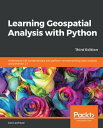 Learning Geospatial Analysis with Python Understand GIS fundamentals and perform remote sensing data analysis using Python 3.7【電子書籍】[ Joel Lawhead ] 楽天Kobo電子書籍ストア | <p><b>Learn the core concepts of geospatial data analysis for building actionable and insightful GIS applications</b></p><h2>Key Features</h2><ul><li>Create GIS solutions using the new features introduced in Python 3.7</li><li>Explore a range of GIS tools and libraries such as PostGIS, QGIS, and PROJ</li><li>Learn to automate geospatial analysis workflows using Python and Jupyter</li></ul><h2>Book Description</h2>Geospatial analysis is used in almost every domain you can think of, including defense, farming, and even medicine. With this systematic guide, you'll get started with geographic information system (GIS) and remote sensing analysis using the latest features in Python. This book will take you through GIS techniques, geodatabases, geospatial raster data, and much more using the latest built-in tools and libraries in Python 3.7. You'll learn everything you need to know about using software packages or APIs and generic algorithms that can be used for different situations. Furthermore, you'll learn how to apply simple Python GIS geospatial processes to a variety of problems, and work with remote sensing data. By the end of the book, you'll be able to build a generic corporate system, which can be implemented in any organization to manage customer support requests and field support personnel.<h2>What you will learn</h2><ul><li>Automate geospatial analysis workflows using Python</li><li>Code the simplest possible GIS in just 60 lines of Python</li><li>Create thematic maps with Python tools such as PyShp, OGR, and the Python Imaging Library</li><li>Understand the different formats that geospatial data comes in</li><li>Produce elevation contours using Python tools</li><li>Create flood inundation models</li><li>Apply geospatial analysis to real-time data tracking and storm chasing</li></ul><h2>Who this book is for</h2><p>This book is for Python developers, researchers, or analysts who want to perform geospatial modeling and GIS analysis with Python. Basic knowledge of digital mapping and analysis using Python or other scripting languages will be helpful.</p>画面が切り替わりますので、しばらくお待ち下さい。 ※ご購入は、楽天kobo商品ページからお願いします。※切り替わらない場合は、こちら をクリックして下さい。 ※このページからは注文できません。 | 5,166円 |
 Introductory Fisheries Analyses with R【電子書籍】[ Derek H. Ogle ] 楽天Kobo電子書籍ストア | <p><em>A How-To Guide for Conducting Common Fisheries-Related Analyses in R</em></p> <p><strong>Introductory Fisheries Analyses with R</strong> provides detailed instructions on performing basic fisheries stock assessment analyses in the R environment. Accessible to practicing fisheries scientists as well as advanced undergraduate and graduate students, the book demonstrates the flexibility and power of R, offers insight into the reproducibility of script-based analyses, and shows how the use of R leads to more efficient and productive work in fisheries science.</p> <p>The first three chapters present a minimal introduction to the R environment that builds a foundation for the fisheries-specific analyses in the remainder of the book. These chapters help you become familiar with R for basic fisheries analyses and graphics.</p> <p>Subsequent chapters focus on methods to analyze age comparisons, age-length keys, size structure, weight-length relationships, condition, abundance (from capture-recapture and depletion data), mortality rates, individual growth, and the stock-recruit relationship. The fundamental statistical methods of linear regression, analysis of variance (ANOVA), and nonlinear regression are demonstrated within the contexts of these common fisheries analyses. For each analysis, the author completely explains the R functions and provides sufficient background information so that you can confidently implement each method.</p> <p>Web Resource The author’s website at derekogle.com/IFAR/ includes the data files and R code for each chapter, enabling you to reproduce the results in the book as well as create your own scripts. The site also offers supplemental code for more advanced analyses and practice exercises for every chapter.</p>画面が切り替わりますので、しばらくお待ち下さい。 ※ご購入は、楽天kobo商品ページからお願いします。※切り替わらない場合は、こちら をクリックして下さい。 ※このページからは注文できません。 | 10,108円 |
 Interactions of Quantum Affine Algebras with Cluster Algebras, Current Algebras and Categorification In honor of Vyjayanthi Chari on the occasion of her 60th birthday【電子書籍】 楽天Kobo電子書籍ストア | <p>This volume collects chapters that examine representation theory as connected with affine Lie algebras and their quantum analogues, in celebration of the impact Vyjayanthi Chari has had on this area. The opening chapters are based on mini-courses given at the conference “Interactions of Quantum Affine Algebras with Cluster Algebras, Current Algebras and Categorification”, held on the occasion of Chari’s 60th birthday at the Catholic University of America in Washington D.C., June 2018. The chapters that follow present a broad view of the area, featuring surveys, original research, and an overview of Vyjayanthi Chari’s significant contributions. Written by distinguished experts in representation theory, a range of topics are covered, including:</p> <ul> <li>String diagrams and categorification</li> <li>Quantum affine algebras and cluster algebras</li> <li>Steinberg groups for Jordan pairs</li> <li>Dynamical quantum determinants and Pfaffians</li> </ul> <p><em>Interactions of Quantum Affine Algebras with Cluster Algebras, Current Algebras and Categorification</em> will be an ideal resource for researchers in the fields of representation theory and mathematical physics.</p>画面が切り替わりますので、しばらくお待ち下さい。 ※ご購入は、楽天kobo商品ページからお願いします。※切り替わらない場合は、こちら をクリックして下さい。 ※このページからは注文できません。 | 13,369円 |
 Psychiatrists on Psychiatry Conversations with leaders【電子書籍】 楽天Kobo電子書籍ストア | <p>Over the past 70 years or so, psychiatry has come out of the shadows. With it, has come the truly exceptional leaders that have spearheaded the investigations, interventions, medications, and developments in new therapies, that have contributed to this change and helped shape psychiatry as a discipline. These legendary personalities have helped develop entirely new schools of thought as well as challenge both dogma and stigma that have hounded psychiatry and psychiatrists. They've had a profound impact on policies and have been mentors, supervisors, and role models to new generations of young psychiatrists, creating an environment and the foundations for further developments of the discipline. Comprising 26 unique interviews, the conversations in this fascinating book tell of numerous personal and professional challenges on multiple fronts, and how these have been overcome. Their stories of achievements, struggles, and leadership are truly exceptional sources of inspiration for generations to come. Capturing the compelling personal experiences and views of some of the great thought leaders in psychiatry, the insights in this book will appeal to future generations of academics, clinicians, health care professionals, as well as anyone with an appetite for a diverse array of life stories.</p>画面が切り替わりますので、しばらくお待ち下さい。 ※ご購入は、楽天kobo商品ページからお願いします。※切り替わらない場合は、こちら をクリックして下さい。 ※このページからは注文できません。 | 5,011円 |
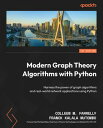 Modern Graph Theory Algorithms with Python Harness the power of graph algorithms and real-world network applications using Python【電子書籍】[ Franck Kalala Mutombo ] 楽天Kobo電子書籍ストア | <p><b>Solve challenging and computationally intensive analytics problems by leveraging network science and graph algorithms </b></p><h2>Key Features</h2><ul><li>Learn how to wrangle different types of datasets and analytics problems into networks</li><li>Leverage graph theoretic algorithms to analyze data efficiently</li><li>Apply the skills you gain to solve a variety of problems through case studies in Python</li><li>Purchase of the print or Kindle book includes a free PDF eBook</li></ul><h2>Book Description</h2>We are living in the age of big data, and scalable solutions are a necessity. Network science leverages the power of graph theory and flexible data structures to analyze big data at scale. This book guides you through the basics of network science, showing you how to wrangle different types of data (such as spatial and time series data) into network structures. You’ll be introduced to core tools from network science to analyze real-world case studies in Python. As you progress, you’ll find out how to predict fake news spread, track pricing patterns in local markets, forecast stock market crashes, and stop an epidemic spread. Later, you’ll learn about advanced techniques in network science, such as creating and querying graph databases, classifying datasets with graph neural networks (GNNs), and mining educational pathways for insights into student success. Case studies in the book will provide you with end-to-end examples of implementing what you learn in each chapter. By the end of this book, you’ll be well-equipped to wrangle your own datasets into network science problems and scale solutions with Python.<h2>What you will learn</h2><ul><li>Transform different data types, such as spatial data, into network formats</li><li>Explore common network science tools in Python</li><li>Discover how geometry impacts spreading processes on networks</li><li>Implement machine learning algorithms on network data features</li><li>Build and query graph databases</li><li>Explore new frontiers in network science such as quantum algorithms</li></ul><h2>Who this book is for</h2><p>If you’re a researcher or industry professional analyzing data and are curious about network science approaches to data, this book is for you. To get the most out of the book, basic knowledge of Python, including pandas and NumPy, as well as some experience working with datasets is required. This book is also ideal for anyone interested in network science and learning how graph algorithms are used to solve science and engineering problems. R programmers may also find this book helpful as many algorithms also have R implementations.</p>画面が切り替わりますので、しばらくお待ち下さい。 ※ご購入は、楽天kobo商品ページからお願いします。※切り替わらない場合は、こちら をクリックして下さい。 ※このページからは注文できません。 | 3,874円 |
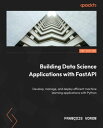 Building Data Science Applications with FastAPI Develop, manage, and deploy efficient machine learning applications with Python【電子書籍】[ Fran?ois Voron ] 楽天Kobo電子書籍ストア | <p><b>Learn all the features and best practices of FastAPI to build, deploy, and monitor powerful data science and AI apps, like object detection or image generation. Purchase of the print or Kindle book includes a free PDF eBook</b></p><h4>Key Features</h4><ul><li>Uncover the secrets of FastAPI, including async I/O, type hinting, and dependency injection</li><li>Learn to add authentication, authorization, and interaction with databases in a FastAPI backend</li><li>Develop real-world projects using pre-trained AI models</li></ul><h4>Book Description</h4>Building Data Science Applications with FastAPI is the go-to resource for creating efficient and dependable data science API backends. This second edition incorporates the latest Python and FastAPI advancements, along with two new AI projects ? a real-time object detection system and a text-to-image generation platform using Stable Diffusion. The book starts with the basics of FastAPI and modern Python programming. You'll grasp FastAPI's robust dependency injection system, which facilitates seamless database communication, authentication implementation, and ML model integration. As you progress, you'll learn testing and deployment best practices, guaranteeing high-quality, resilient applications. Throughout the book, you'll build data science applications using FastAPI with the help of projects covering common AI use cases, such as object detection and text-to-image generation. These hands-on experiences will deepen your understanding of using FastAPI in real-world scenarios. By the end of this book, you'll be well equipped to maintain, design, and monitor applications to meet the highest programming standards using FastAPI, empowering you to create fast and reliable data science API backends with ease while keeping up with the latest advancements.<h4>What you will learn</h4><ul><li>Explore the basics of modern Python and async I/O programming</li><li>Get to grips with basic and advanced concepts of the FastAPI framework</li><li>Deploy a performant and reliable web backend for a data science application</li><li>Integrate common Python data science libraries into a web backend</li><li>Integrate an object detection algorithm into a FastAPI backend</li><li>Build a distributed text-to-image AI system with Stable Diffusion</li><li>Add metrics and logging and learn how to monitor them</li></ul><h4>Who this book is for</h4><p>This book is for data scientists and software developers interested in gaining knowledge of FastAPI and its ecosystem to build data science applications. Basic knowledge of data science and machine learning concepts and how to apply them in Python is recommended.</p>画面が切り替わりますので、しばらくお待ち下さい。 ※ご購入は、楽天kobo商品ページからお願いします。※切り替わらない場合は、こちら をクリックして下さい。 ※このページからは注文できません。 | 4,304円 |
 OSCP Offensive Security Certified Professional Practice Tests With Answers To Pass the OSCP Ethical Hacking Certification Exam【電子書籍】[ Jake T Mills ] 楽天Kobo電子書籍ストア | <p>Embark on a transformative journey into the world of cybersecurity mastery with mastering offensive security. This comprehensive guide is meticulously crafted to propel aspiring professionals through the intricate realm of offensive security, serving as an indispensable roadmap to conquering the challenges of the coveted Offensive Security Certified Professional (OSCP) certification.</p> <p>Delve into a multifaceted exploration of offensive security practices, meticulously designed to equip enthusiasts and seasoned professionals alike with the prowess and acumen required to excel in the ever-evolving cybersecurity landscape.</p> <p>Inside this Guide:</p> <p>Thorough Examination: Uncover the intricacies of the OSCP certification exam, unraveling its structure, prerequisites, and the core competencies essential for success.</p> <p>Strategic Foundations: Craft a robust study plan, cultivate technical expertise, and leverage an array of tools and resources tailored to fortify your knowledge and sharpen your offensive security skills.</p> <p>In-depth Domains: Explore an array of domains, including reconnaissance techniques, vulnerability identification, exploit development, buffer overflow attacks, web application vulnerabilities, privilege escalation, and advanced exploitation methods.</p> <p>Hands-on Reinforcement: Engage with practice questions and detailed answers, translating theoretical concepts into practical applications. Reinforce your understanding through real-world scenarios and challenges.</p> <p>Ethical Mindset: Embrace ethical practices and responsible utilization of offensive security techniques, instilling an ethos of integrity and ethical conduct in the pursuit of cybersecurity excellence.</p> <p>This guide is a transformative expedition that prepares you not only for an exam but also for a rewarding career in offensive security. Unlock the door to expertise, ethical excellence, and proficiency in securing digital landscapes against evolving threats.</p> <p>Whether you're a budding cybersecurity enthusiast or a seasoned professional seeking to fortify your skill set, this book is your gateway to success. Equip yourself with the knowledge, strategies, and expertise essential not just for acing an exam, but for thriving in a dynamic cybersecurity career.</p> <p>Begin your odyssey, hone your skills, and emerge as a formidable force in the world of offensive security.</p>画面が切り替わりますので、しばらくお待ち下さい。 ※ご購入は、楽天kobo商品ページからお願いします。※切り替わらない場合は、こちら をクリックして下さい。 ※このページからは注文できません。 | 1,500円 |
 Managing Projects with GNU Make The Power of GNU Make for Building Anything【電子書籍】[ Robert Mecklenburg ] 楽天Kobo電子書籍ストア | <p>The utility simply known as <em>make</em> is one of the most enduring features of both Unix and other operating systems. First invented in the 1970s, <em>make</em> still turns up to this day as the central engine in most programming projects; it even builds the Linux kernel. In the third edition of the classic <em>Managing Projects with GNU make</em>, readers will learn why this utility continues to hold its top position in project build software, despite many younger competitors.The premise behind <em>make</em> is simple: after you change source files and want to rebuild your program or other output files, <em>make</em> checks timestamps to see what has changed and rebuilds just what you need, without wasting time rebuilding other files. But on top of this simple principle, <em>make</em> layers a rich collection of options that lets you manipulate multiple directories, build different versions of programs for different platforms, and customize your builds in other ways.This edition focuses on the GNU version of <em>make</em>, which has deservedly become the industry standard. GNU make contains powerful extensions that are explored in this book. It is also popular because it is free software and provides a version for almost every platform, including a version for Microsoft Windows as part of the free Cygwin project. <em>Managing Projects with GNU make</em>, 3rd Edition provides guidelines on meeting the needs of large, modern projects. Also added are a number of interesting advanced topics such as portability, parallelism, and use with Java.Robert Mecklenburg, author of the third edition, has used <em>make</em> for decades with a variety of platforms and languages. In this book he zealously lays forth how to get your builds to be as efficient as possible, reduce maintenance, avoid errors, and thoroughly understand what <em>make</em> is doing. Chapters on C++ and Java provide makefile entries optimized for projects in those languages. The author even includes a discussion of the makefile used to build the book.</p>画面が切り替わりますので、しばらくお待ち下さい。 ※ご購入は、楽天kobo商品ページからお願いします。※切り替わらない場合は、こちら をクリックして下さい。 ※このページからは注文できません。 | 2,895円 |
 Simulating Nonlinear Circuits with Python Power Electronics An Open-Source Simulator, Based on Python?【電子書籍】[ Shivkumar V. Iyer ] 楽天Kobo電子書籍ストア | <p>This book provides readers with an in-depth discussion of circuit simulation, combining basic electrical engineering circuit theory with Python programming. It fills an information gap by describing the development of Python Power Electronics, an open-source software for simulating circuits, and demonstrating its use in a sample circuit. Unlike typical books on circuit theory that describe how circuits can be solved mathematically, followed by examples of simulating circuits using specific, commercial software, this book has a different approach and focus. The author begins by describing every aspect of the open-source software, in the context of non-linear power electronic circuits, as a foundation for aspiring or practicing engineers to embark on further development of open source software for different purposes. By demonstrating explicitly the operation of the software through algorithms, this book brings together the fields of electrical engineering and software technology.</p>画面が切り替わりますので、しばらくお待ち下さい。 ※ご購入は、楽天kobo商品ページからお願いします。※切り替わらない場合は、こちら をクリックして下さい。 ※このページからは注文できません。 | 10,331円 |
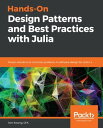 Hands-On Design Patterns and Best Practices with Julia Proven solutions to common problems in software design for Julia 1.x【電子書籍】[ Tom Kwong ] 楽天Kobo電子書籍ストア | <p><strong>Design and develop high-performance, reusable, and maintainable applications using traditional and modern Julia patterns with this comprehensive guide</strong></p> <h4>Key Features</h4> <ul> <li>Explore useful design patterns along with object-oriented programming in Julia 1.0</li> <li>Implement macros and metaprogramming techniques to make your code faster, concise, and efficient</li> <li>Develop the skills necessary to implement design patterns for creating robust and maintainable applications</li> </ul> <h4>Book Description</h4> <p>Design patterns are fundamental techniques for developing reusable and maintainable code. They provide a set of proven solutions that allow developers to solve problems in software development quickly. This book will demonstrate how to leverage design patterns with real-world applications.</p> <p>Starting with an overview of design patterns and best practices in application design, you'll learn about some of the most fundamental Julia features such as modules, data types, functions/interfaces, and metaprogramming. You'll then get to grips with the modern Julia design patterns for building large-scale applications with a focus on performance, reusability, robustness, and maintainability. The book also covers anti-patterns and how to avoid common mistakes and pitfalls in development. You'll see how traditional object-oriented patterns can be implemented differently and more effectively in Julia. Finally, you'll explore various use cases and examples, such as how expert Julia developers use design patterns in their open source packages.</p> <p>By the end of this Julia programming book, you'll have learned methods to improve software design, extensibility, and reusability, and be able to use design patterns efficiently to overcome common challenges in software development.</p> <h4>What you will learn</h4> <ul> <li>Master the Julia language features that are key to developing large-scale software applications</li> <li>Discover design patterns to improve overall application architecture and design</li> <li>Develop reusable programs that are modular, extendable, performant, and easy to maintain</li> <li>Weigh up the pros and cons of using different design patterns for use cases</li> <li>Explore methods for transitioning from object-oriented programming to using equivalent or more advanced Julia techniques</li> </ul> <h4>Who this book is for</h4> <p>This book is for beginner to intermediate-level Julia programmers who want to enhance their skills in designing and developing large-scale applications.</p>画面が切り替わりますので、しばらくお待ち下さい。 ※ご購入は、楽天kobo商品ページからお願いします。※切り替わらない場合は、こちら をクリックして下さい。 ※このページからは注文できません。 | 4,151円 |
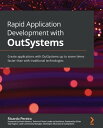 Rapid Application Development with OutSystems Create applications with OutSystems up to seven times faster than with traditional technologies【電子書籍】[ Ricardo Pereira ] 楽天Kobo電子書籍ストア | <p><b>Discover best practices in this illustrated guide to create simple, robust, and scalable software solutions quickly and securely, and focus on what's important - the business and the end customer</b></p><h2>Key Features</h2><ul><li>Discover strategies and tips for low-code and no-code development with the help of useful examples in this full-color guide</li><li>Build enterprise-scale reactive web and mobile applications</li><li>Explore the benefits of low-code development</li></ul><h2>Book Description</h2>OutSystems is a software development platform that speeds up the build phase by abstracting code and making almost everything visual. This means replacing textual language with visual artifacts that avoid lexical errors and speed up code composition using accelerators and predefined templates. The book begins by walking you through the fundamentals of the technology, along with a general overview of end-to-end web and mobile software development. You'll learn how to configure your personal area in the cloud and use the OutSystems IDE to connect with it. The book then shows you how to build a web application based on the best architectural and developmental practices in the market, and takes the same approach for the mobile paradigm. As you advance, you'll find out how to develop the same application, and the great potential of reusing code from one paradigm in another and the symbiosis between them is showcased.The only application that'll differ from the application in the exercise is the one used in business process technology (BPT), with a focus on a common market use case. By the end of this OutSystems book, you'll be able to develop enterprise-level applications on the web and mobile, integrating them with third parties and other systems on the market. You'll also understand the concepts of performance, security, and software construction and be able to apply them effectively.<h2>What you will learn</h2><ul><li>Get to grips with the OutSystems infrastructure</li><li>Develop reactive web and mobile applications in OutSystems using best practices in Service Studio</li><li>Define and design Architecture Canvas (3-Layer Canvas) for your applications</li><li>Integrate with external systems in OutSystems</li><li>Enhance applications with BPT</li><li>Manage and monitor your applications in the OutSystems infrastructure</li></ul><h2>Who this book is for</h2><p>This book is for back-end developers, tech leaders, UX/UI developers, frontend developers, (in general, full-stack developers), tech companies, and enterprises looking to learn how to develop web and mobile software quickly and disruptively by leveraging OutSystems, one of the most low-code platforms in the market. An IT background is not mandatory; however, experience in SQL, JavaScript, HTML, CSS, and C\# is required to get started with this book.</p>画面が切り替わりますので、しばらくお待ち下さい。 ※ご購入は、楽天kobo商品ページからお願いします。※切り替わらない場合は、こちら をクリックして下さい。 ※このページからは注文できません。 | 6,027円 |
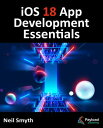 iOS 18 App Development Essentials Developing iOS Apps with SwiftUI, Swift, and Xcode 16【電子書籍】[ Neil Smyth ] 楽天Kobo電子書籍ストア | <p>This book aims to teach the skills necessary to build iOS 18 applications using SwiftUI, Xcode 16, and the Swift programming language.</p> <p>Beginning with the basics, this book outlines the steps to set up an iOS development environment, together with an introduction to using Swift Playgrounds to learn and experiment with Swift.</p> <p>The book also includes in-depth chapters introducing the Swift programming language, including data types, control flow, functions, object-oriented programming, property wrappers, structured concurrency, and error handling.</p> <p>A guided tour of Xcode in SwiftUI development mode follows an introduction to the key concepts of SwiftUI and project architecture. The book also covers creating custom SwiftUI views and explains how these views are combined to create user interface layouts, including stacks, frames, and forms.</p> <p>Other topics covered include data handling using state properties and observable, state, and environment objects, as are key user interface design concepts such as modifiers, lists, tabbed views, context menus, user interface navigation, and outline groups.</p> <p>The book also includes chapters covering graphics and chart drawing, user interface animation, view transitions and gesture handling, WidgetKit, Live Activities, document-based apps, Core Data, SwiftData, and CloudKit.</p> <p>Chapters also explain how to integrate SwiftUI views into existing UIKit-based projects and integrate UIKit code into SwiftUI.</p> <p>Finally, the book explains how to package up a completed app and upload it to the App Store for publication.</p> <p>Along the way, the topics covered in the book are put into practice through detailed tutorials, the source code for which is also available for download, and over 50 online knowledge test quizzes.</p> <p>The aim of this book, therefore, is to teach you the skills to build your own apps for iOS 18 using SwiftUI. Assuming you are ready to download the iOS 18 SDK and Xcode 16 and have an Apple Mac system, you are ready to get started.</p>画面が切り替わりますので、しばらくお待ち下さい。 ※ご購入は、楽天kobo商品ページからお願いします。※切り替わらない場合は、こちら をクリックして下さい。 ※このページからは注文できません。 | 5,453円 |
 Machine Learning with PyTorch and Scikit-Learn Develop machine learning and deep learning models with Python【電子書籍】[ Sebastian Raschka ] 楽天Kobo電子書籍ストア | <p><b>This book of the bestselling and widely acclaimed Python Machine Learning series is a comprehensive guide to machine and deep learning using PyTorch s simple to code framework. Purchase of the print or Kindle book includes a free eBook in PDF format.</b></p><h2>Key Features</h2><ul><li>Learn applied machine learning with a solid foundation in theory</li><li>Clear, intuitive explanations take you deep into the theory and practice of Python machine learning</li><li>Fully updated and expanded to cover PyTorch, transformers, XGBoost, graph neural networks, and best practices</li></ul><h2>Book Description</h2>Machine Learning with PyTorch and Scikit-Learn is a comprehensive guide to machine learning and deep learning with PyTorch. It acts as both a step-by-step tutorial and a reference you'll keep coming back to as you build your machine learning systems. Packed with clear explanations, visualizations, and examples, the book covers all the essential machine learning techniques in depth. While some books teach you only to follow instructions, with this machine learning book, we teach the principles allowing you to build models and applications for yourself. Why PyTorch? PyTorch is the Pythonic way to learn machine learning, making it easier to learn and simpler to code with. This book explains the essential parts of PyTorch and how to create models using popular libraries, such as PyTorch Lightning and PyTorch Geometric. You will also learn about generative adversarial networks (GANs) for generating new data and training intelligent agents with reinforcement learning. Finally, this new edition is expanded to cover the latest trends in deep learning, including graph neural networks and large-scale transformers used for natural language processing (NLP). This PyTorch book is your companion to machine learning with Python, whether you're a Python developer new to machine learning or want to deepen your knowledge of the latest developments.<h2>What you will learn</h2><ul><li>Explore frameworks, models, and techniques for machines to learn from data</li><li>Use scikit-learn for machine learning and PyTorch for deep learning</li><li>Train machine learning classifiers on images, text, and more</li><li>Build and train neural networks, transformers, and boosting algorithms</li><li>Discover best practices for evaluating and tuning models</li><li>Predict continuous target outcomes using regression analysis</li><li>Dig deeper into textual and social media data using sentiment analysis</li></ul><h2>Who this book is for</h2><p>If you have a good grasp of Python basics and want to start learning about machine learning and deep learning, then this is the book for you. This is an essential resource written for developers and data scientists who want to create practical machine learning and deep learning applications using scikit-learn and PyTorch. Before you get started with this book, you’ll need a good understanding of calculus, as well as linear algebra.</p>画面が切り替わりますので、しばらくお待ち下さい。 ※ご購入は、楽天kobo商品ページからお願いします。※切り替わらない場合は、こちら をクリックして下さい。 ※このページからは注文できません。 | 4,734円 |
 Expert C++ Become a proficient programmer by learning coding best practices with C++17 and C++20's latest features【電子書籍】[ Vardan Grigoryan ] 楽天Kobo電子書籍ストア | <p><strong>Design and architect real-world scalable C++ applications by exploring advanced techniques in low-level programming, object-oriented programming (OOP), the Standard Template Library (STL), metaprogramming, and concurrency</strong></p> <h4>Key Features</h4> <ul> <li>Design professional-grade, maintainable apps by learning advanced concepts such as functional programming, templates, and networking</li> <li>Apply design patterns and best practices to solve real-world problems</li> <li>Improve the performance of your projects by designing concurrent data structures and algorithms</li> </ul> <h4>Book Description</h4> <p>C++ has evolved over the years and the latest release ? C++20 ? is now available. Since C++11, C++ has been constantly enhancing the language feature set. With the new version, you'll explore an array of features such as concepts, modules, ranges, and coroutines. This book will be your guide to learning the intricacies of the language, techniques, C++ tools, and the new features introduced in C++20, while also helping you apply these when building modern and resilient software.</p> <p>You'll start by exploring the latest features of C++, and then move on to advanced techniques such as multithreading, concurrency, debugging, monitoring, and high-performance programming. The book will delve into object-oriented programming principles and the C++ Standard Template Library, and even show you how to create custom templates. After this, you'll learn about different approaches such as test-driven development (TDD), behavior-driven development (BDD), and domain-driven design (DDD), before taking a look at the coding best practices and design patterns essential for building professional-grade applications. Toward the end of the book, you will gain useful insights into the recent C++ advancements in AI and machine learning.</p> <p>By the end of this C++ programming book, you'll have gained expertise in real-world application development, including the process of designing complex software.</p> <h4>What you will learn</h4> <ul> <li>Understand memory management and low-level programming in C++ to write secure and stable applications</li> <li>Discover the latest C++20 features such as modules, concepts, ranges, and coroutines</li> <li>Understand debugging and testing techniques and reduce issues in your programs</li> <li>Design and implement GUI applications using Qt5</li> <li>Use multithreading and concurrency to make your programs run faster</li> <li>Develop high-end games by using the object-oriented capabilities of C++</li> <li>Explore AI and machine learning concepts with C++</li> </ul> <h4>Who this book is for</h4> <p>This C++ book is for experienced C++ developers who are looking to take their knowledge to the next level and perfect their skills in building professional-grade applications.</p>画面が切り替わりますので、しばらくお待ち下さい。 ※ご購入は、楽天kobo商品ページからお願いします。※切り替わらない場合は、こちら をクリックして下さい。 ※このページからは注文できません。 | 4,151円 |
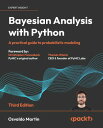 Bayesian Analysis with Python A practical guide to probabilistic modeling【電子書籍】[ Osvaldo Martin ] 楽天Kobo電子書籍ストア | <p><b>Learn the fundamentals of Bayesian modeling using state-of-the-art Python libraries, such as PyMC, ArviZ, Bambi, and more, guided by an experienced Bayesian modeler who contributes to these libraries</b></p><h2>Key Features</h2><ul><li>Conduct Bayesian data analysis with step-by-step guidance</li><li>Gain insight into a modern, practical, and computational approach to Bayesian statistical modeling</li><li>Enhance your learning with best practices through sample problems and practice exercises</li><li>Purchase of the print or Kindle book includes a free PDF eBook.</li></ul><h2>Book Description</h2>The third edition of Bayesian Analysis with Python serves as an introduction to the main concepts of applied Bayesian modeling using PyMC, a state-of-the-art probabilistic programming library, and other libraries that support and facilitate modeling like ArviZ, for exploratory analysis of Bayesian models; Bambi, for flexible and easy hierarchical linear modeling; PreliZ, for prior elicitation; PyMC-BART, for flexible non-parametric regression; and Kulprit, for variable selection. In this updated edition, a brief and conceptual introduction to probability theory enhances your learning journey by introducing new topics like Bayesian additive regression trees (BART), featuring updated examples. Refined explanations, informed by feedback and experience from previous editions, underscore the book's emphasis on Bayesian statistics. You will explore various models, including hierarchical models, generalized linear models for regression and classification, mixture models, Gaussian processes, and BART, using synthetic and real datasets. By the end of this book, you will possess a functional understanding of probabilistic modeling, enabling you to design and implement Bayesian models for your data science challenges. You'll be well-prepared to delve into more advanced material or specialized statistical modeling if the need arises.<h2>What you will learn</h2><ul><li>Build probabilistic models using PyMC and Bambi</li><li>Analyze and interpret probabilistic models with ArviZ</li><li>Acquire the skills to sanity-check models and modify them if necessary</li><li>Build better models with prior and posterior predictive checks</li><li>Learn the advantages and caveats of hierarchical models</li><li>Compare models and choose between alternative ones</li><li>Interpret results and apply your knowledge to real-world problems</li><li>Explore common models from a unified probabilistic perspective</li><li>Apply the Bayesian framework's flexibility for probabilistic thinking</li></ul><h2>Who this book is for</h2><p>If you are a student, data scientist, researcher, or developer looking to get started with Bayesian data analysis and probabilistic programming, this book is for you. The book is introductory, so no previous statistical knowledge is required, although some experience in using Python and scientific libraries like NumPy is expected.</p>画面が切り替わりますので、しばらくお待ち下さい。 ※ご購入は、楽天kobo商品ページからお願いします。※切り替わらない場合は、こちら をクリックして下さい。 ※このページからは注文できません。 | 4,304円 |
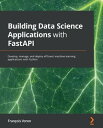 Building Data Science Applications with FastAPI Develop, manage, and deploy efficient machine learning applications with Python【電子書籍】[ Francois Voron ] 楽天Kobo電子書籍ストア | <p>Get well-versed with FastAPI features and best practices for testing, monitoring, and deployment to run high-quality and robust data science applications Key Features ? Cover the concepts of the FastAPI framework, including aspects relating to asynchronous programming, type hinting, and dependency injection ? Develop efficient RESTful APIs for data science with modern Python ? Build, test, and deploy high performing data science and machine learning systems with FastAPI Book Description FastAPI is a web framework for building APIs with Python 3.6 and its later versions based on standard Python-type hints. With this book, you'll be able to create fast and reliable data science API backends using practical examples. This book starts with the basics of the FastAPI framework and associated modern Python programming language concepts. You'll be taken through all the aspects of the framework, including its powerful dependency injection system and how you can use it to communicate with databases, implement authentication and integrate machine learning models. Later, you'll cover best practices relating to testing and deployment to run a high-quality and robust application. You'll also be introduced to the extensive ecosystem of Python data science packages. As you progress, you'll learn how to build data science applications in Python using FastAPI. The book also demonstrates how to develop fast and efficient machine learning prediction backends and test them to achieve the best performance. Finally, you'll see how to implement a real-time face detection system using WebSockets and a web browser as a client. By the end of this FastAPI book, you'll have not only learned how to implement Python in data science projects but also how to maintain and design them to meet high programming standards with the help of FastAPI. What you will learn ? Explore the basics of modern Python and async I/O programming ? Get to grips with basic and advanced concepts of the FastAPI framework ? Implement a FastAPI dependency to efficiently run a machine learning model ? Integrate a simple face detection algorithm in a FastAPI backend ? Integrate common Python data science libraries in a web backend ? Deploy a performant and reliable web backend for a data science application Who this book is for This Python data science book is for data scientists and software developers interested in gaining knowledge of FastAPI and its ecosystem to build data science applications. Basic knowledge of data science and machine learning concepts and how to apply them in Python is recommended.</p>画面が切り替わりますので、しばらくお待ち下さい。 ※ご購入は、楽天kobo商品ページからお願いします。※切り替わらない場合は、こちら をクリックして下さい。 ※このページからは注文できません。 | 6,300円 |